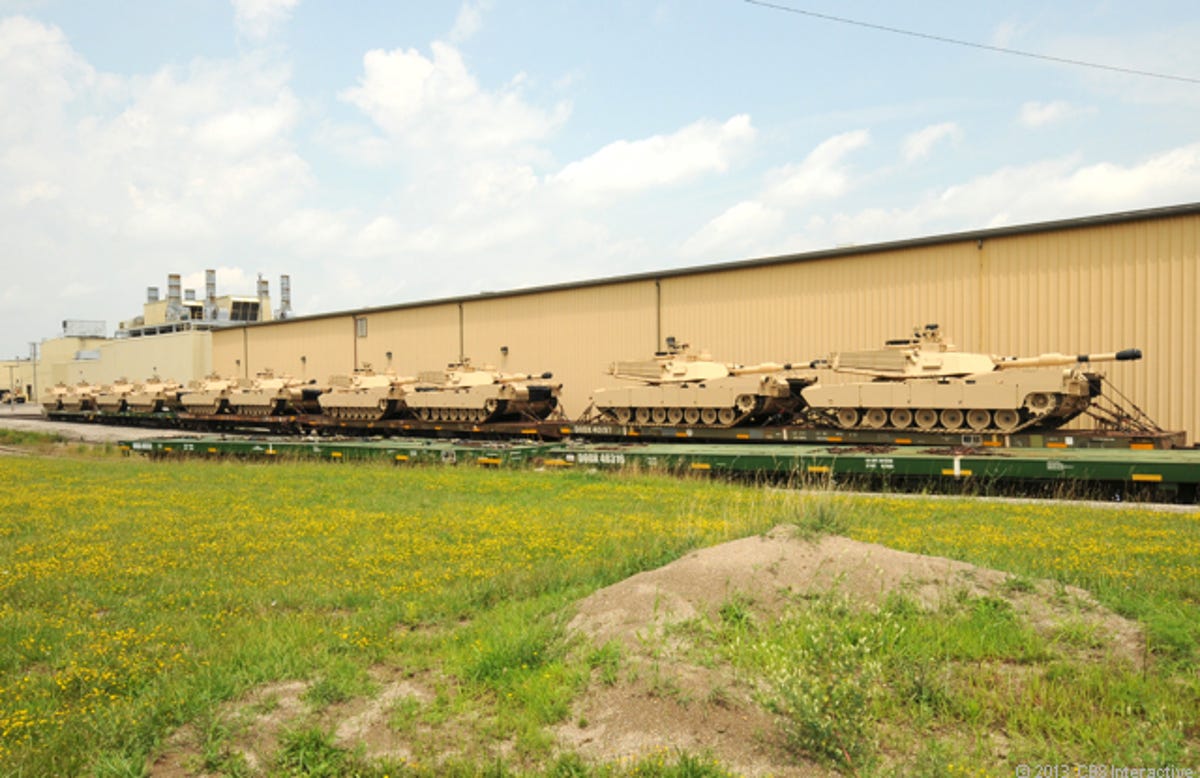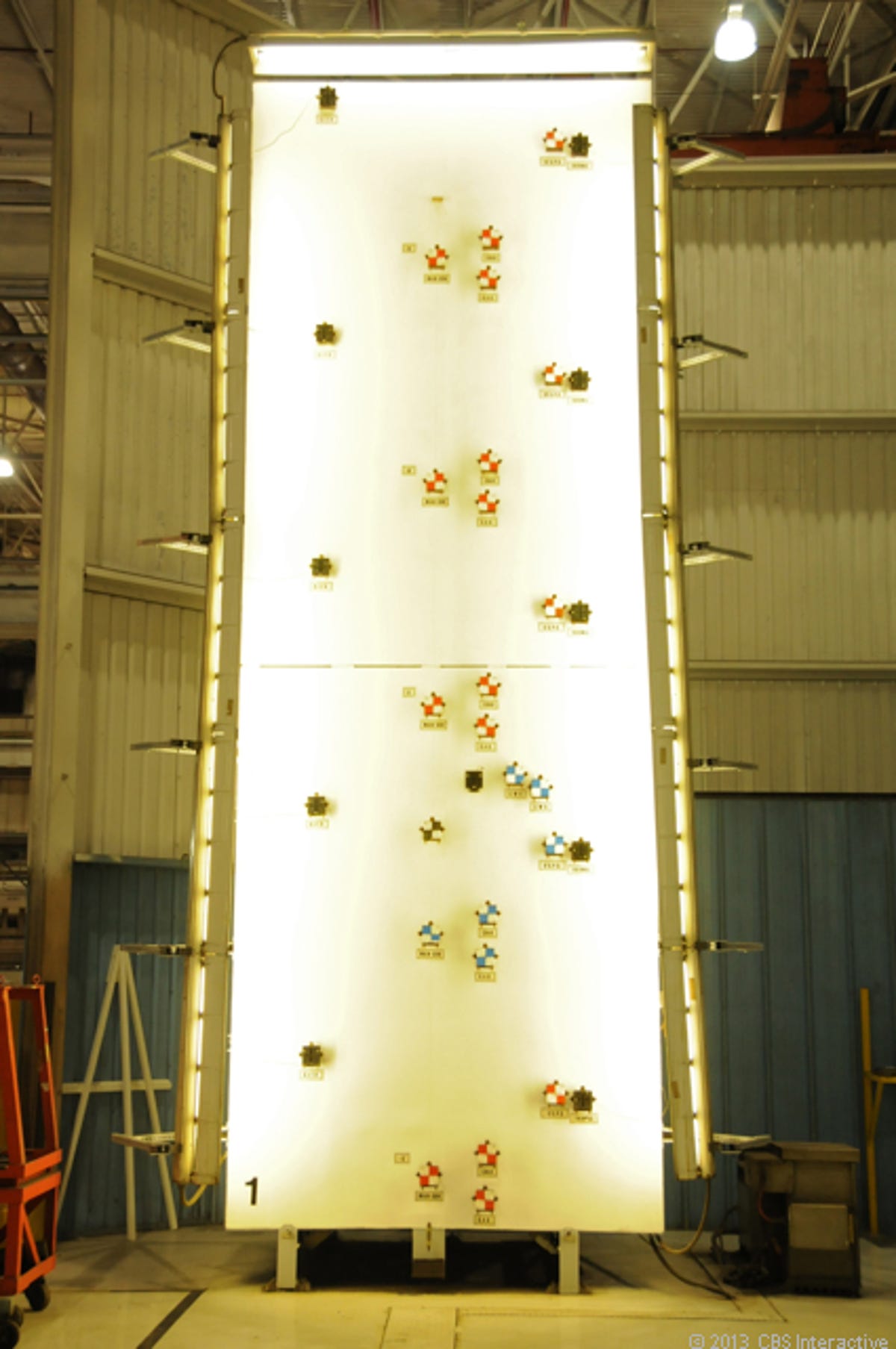Building the U.S. Army's M1A2 Abrams tank (pictures)
Since 1980, the Army has depended on the Abrams for battlefield superiority in combat. As part of Road Trip 2013, CNET's Daniel Terdiman checked out how these battle-tested vehicles are forged.

Abrams tanks ready to roll
LIMA, Ohio -- For 35 years, Abrams tanks have been rolling off the assembly lines of General Dynamics Land Systems' Joint Systems Manufacturing Center plant in this western Ohio town, destined for the U.S. Army (and a few foreign customers).
In 1996, the plant stopped making brand-new hulls and turrets for the the U.S. Army's Abrams tanks, instead choosing to recondition older M1A2 systems that were still in working order.
As part of Road Trip 2013, CNET reporter Daniel Terdiman visited the Lima plant to see how GDLS manufactures an Abrams tank.
Here, we see a line of tanks that have gone through the production process and have been vetted by the government's Defense Contract Management Agency. Once they're strapped down and ready to roll away on rails, the tanks become the property and the responsibility of the Army.
Rusties on rails
Before the production of a reconditioned M1A2 Abrams tank can begin, the plant first receives rail cars full of decommissioned tanks, known as a "rusty."
Rusty and shot-blasted hulls
After the plant receives the "rusties," workers take the old hulls and turrets and put them through a shot-blasting process, stripping them of years of rust. On the left is a rusty, and on the right is a hull that has been shot-blasted.
Rusty hull
A look at the interior of the hull of a "rusty" that was first built in the early 1990s.
De-masked hull
After the hulls and turrets have been shot-blasted and painted, they then go through the process of being de-masked. This hull has already gone through that step, meaning it is now ready for the assembly line.
Cannon assembly
Once the turrets have been shot-blasted and de-masked, they have a set of so-called ammo doors added to them. After that, the cannons are mounted on them. But first, workers test the cannon recoil to ensure that the shock of firing it is properly absorbed inside the turret.
Completed turret
After the cannon is installed on the turret, the turrets are moved to the assembly line for the addition of interior equipment and systems. CNET was not able to see this part of the assembly process due to its sensitive nature.
Abrams turret
This is a completed turret coming off the assembly line. It will be set aside until later in the process, when it will be married with a completed hull.
The basket
This is what's known as "the basket." Essentially, it is the pod inside of which three of the tank's crew members -- the gunner, the commander, and the loader, as well as 2,000 pounds of electronics and gear -- will sit. The basket is loaded up from underneath the turret and installed.
Station 3
This is Station 3, where an Abrams hull that has had many of its internal equipment and systems installed, is lifted off the ground in order to have its suspension components installed.
Road wheels
These are what are known as "road wheels," which are mounted on the Abrams before the tank's track is installed.
Hull assembly line
This is the Abrams hull assembly line. Workers systematically install equipment at a series of stations along the line. A drag line pulls the hulls forward, since they don't have their suspension installed at this point.
Ammo rack
Most of the tank's ammunition is stored in the turret, but some is kept in the hull, in ammunition racks like this one.
Fuel cell
This is one of the Abrams tank's fuel cells, or gas tanks. The Abrams is not particularly fuel-efficient, getting 1.9 gallons to the mile.
Slip ring
Installed at the interior base of the hull, this is the slip ring, a cylinder that allows the tank's turret to turn 360 degrees without its wires ending up tangled.
Fire suppression system
This is the tank's fire suppression system. If a fire breaks out inside, it is designed to automatically pour fire-resistant chemicals into the affected areas.
Hulls lined up
A group of Abrams hulls are lined up as they move through the assembly process. At this point, they have their suspension system installed.
Resting on its own wheels
Early in the assembly process, the hulls rest on the ground as they don't have their suspension installed. But at this point, they have had their wheels mounted and can now rest on those wheels.
Systems inside the hull
Midway down the assembly line, a look at some of the equipment and systems inside the hull's interior.
Final drives
Part of the tank's suspension system, these are known as final drives. Essentially, these are gears that transfer power from the transmission to the tank's track.
Sprocket bolted on
A large sprocket is bolted onto the final drives, and this is what moves the tank's track.
FUPP
This is the tank's full-up power pack, or FUPP. It includes the Abrams' engine, transmission, and all cooling apparatus -- the oil coolers and the exhaust. The turbine engine has 1,500 horsepower, and is multi-fuel, meaning that it can work on many different kinds of fuel, from diesel to jet fuel to gasoline to kerosene, and even peanut oil. That gives the tank a great deal of flexibility, which is a major advantage during combat or other activity.
The FUPP is designed to be "plug and play," meaning that if it is damaged or dysfunctional, it is pulled out in its entirety and replaced with a new one.
On the battlefield, this is thought to be a more efficient way of repairing systems. In a case like this, the defective FUPP will usually be taken away to a maintenance area. In combat zones, replacement FUPPs are carried around by heavy trucks, or possibly delivered by aircraft.
Rolled up tracks
Rolls of tank tracks sit on the floor alongside the Abrams assembly line.
Laying down track
In order to install the tank's tracks, they are bolted down at one end, and rolled down on the floor. Then the drag line pulls the tank forward until it sits on top of the track.
Track about to be joined
In order to complete the track installation, a pulley system with winches brings the two ends of the track together, where it is hooked together. Here, we see a track with two ends about to be joined.
Joining the track
A worker in the Lima plant kneels alongside an Abrams tank to make sure the track joining process goes smoothly.
Convertible
This is a "convertible," an Abrams hull that has made its way fully through the assembly process and is now awaiting being married to a completed turret.
Marrying the turret and hull
A completed turret is hoisted onto a completed hull. Afterward, workers will add armor and skirting and tighten the turret properly.
Fire control systems
These are the tank's fire control systems, which are tested after the hull and turret are married.

Target board
Initially, the many different targeting sensors are not calibrated, so this targeting board is designed to help calibrate all the different weapons systems, a process known as "zeroing the scopes." The different colors on the board correspond to different weapons systems, while the different heights correspond to different distances for potential targets.
Sensor on cannon
A sensor is mounted on the tank's cannon.
Test and Accept
Once the main production process is finished, the tanks are moved into a separate building, known as "Test and Accept." Here, they are put through a 1,200 item inspection process by General Dynamics Land Systems (GDLS) employees that involves driving the tanks about 30 miles. This process involves steps as simple as making sure small parts are present -- and if not, installing them on-site -- and others that can take two full days.
Once GDLS has completed its inspection, the government's on-site Defense Contract Management Agency takes over, with its quality assurance inspectors doing their own examination, which involves around 600 to 700 checks. Once the DCMA is satisfied, the tanks are ready to move on.
The Test and Accept process usually takes longer than the production process.
Army-built FUPPs
Most Abrams tanks use full-up power packs built by GDLS, but some Army contracts mandate that the Army builds the FUPPs and delivers them to the plant, where they are installed in the tanks. This is a row of Army-built FUPPs in the test and accept building.
Row of tanks
This is a row of Abrams tanks that have gone through the test and accept process and are awaiting the next step.
No tank through traffic
There aren't too many places on Earth where you can see a sign like this.
Tank hill
One of the inspection steps involves the tanks climbing this artificial hill, engaging their parking brake, turning off the power, waiting a specified amount of time, turning the engine back on, disengaging the brake, and then backing down the hill.

